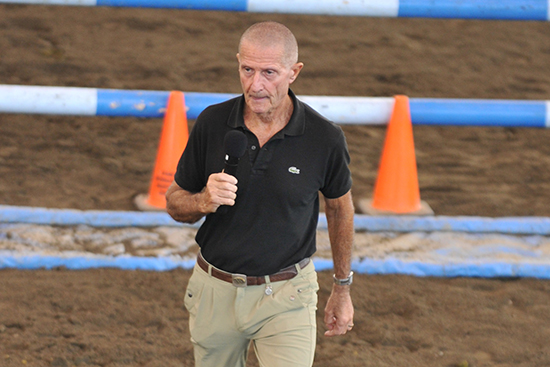 Story by Chris Hector and photos by Roz Neave
Story by Chris Hector and photos by Roz Neave
I guess it is some sort of condemnation of our system of riding that we should still experience something of a shock when George Morris starts each working session with his jumping riders, reprising the classical principles of dressage.
George is working with the same classy group of riders and horses who he had on the first day: Hilary Scott and Pro Ratina, Jamie Kermond and BWP Lincoln, Jamie Grant and Vedette, Vicki Roycroft and Kartoon, Danielle Butcher and Twins Quantum and Amanda Madigan with Vigo.
“You don’t collect a horse, collection is the result of impulsion, rhythm, straightness and engagement – collection is the result. It is nothing to do with this forced over-flexion.”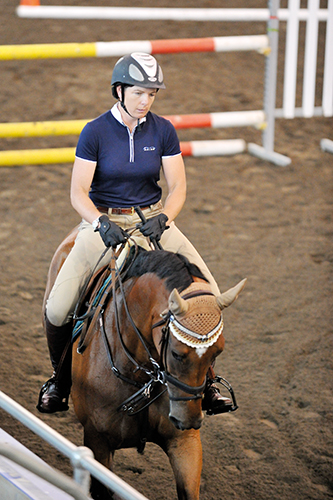
And it comes from? Leg riding.
“When the horse is dead to your legs, don’t kick and make it deader. Use the whip, use the spur. You have to understand the mechanics of the horse being put to the bit – just one quick attack with both spurs and get the horse’s hind legs. I want the poll up and the jaw soft but not over-flexed. I know that this is the fashion, over-bent, over-flexed horses.”
And woe betide the rider that gets rough with a horse: “Temper is ego, not horsemanship, that’s people-ship – this is for the horse not the people…”
And George doesn’t like them to over-flex laterally either:
“The neck is attached to the shoulder and is straight. The first two thirds of the neck should be quite stiff. When we are getting the horse’s shoulder light, be careful not to over-bend to the inside – bend them with the inside leg, not the hand.”
All this talk about mobilizing the shoulder is not some dry academic dressage exercise, it is directly related to the first jumping exercise of the day – rapid turns.
“Have the horse rigorously straight in a straight line. What is important in rapid turns is not the bend, but the rapid mobilization of the shoulder. We are now testing impulsion – forward and back, make it progressive, not abrupt.”
George now has his riders working on a circle, spiraling in: “Spiral and tighten the circle, both hands to the inside together, and your outside leg gets more important.”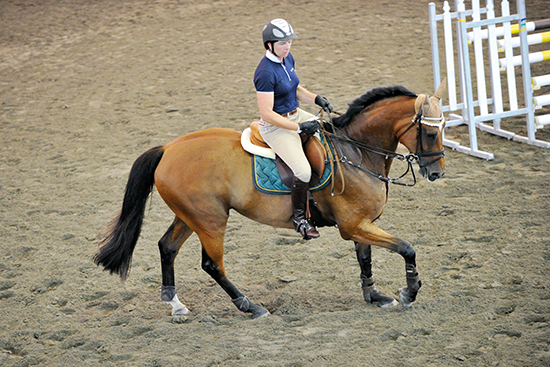
Out of that into halt: “Stretch your spine and halt and canter out of halt. Keep the horse straight and on the bit in the halt.”
Time for the master to walk the walk, and this time he selects Danielle Butcher’s Twins Quantum as his ride for the session.
“The horse is a little above the bit but I absolutely do not lower my hand. I close my hand and resist – not pull – and the horse starts to chew the bit and soften its lower jaw and bends at the poll.”
George was showing how that spiral should be ridden: “Protect the outside of the horse, spiral in, go straight and stretch, then spiral again.”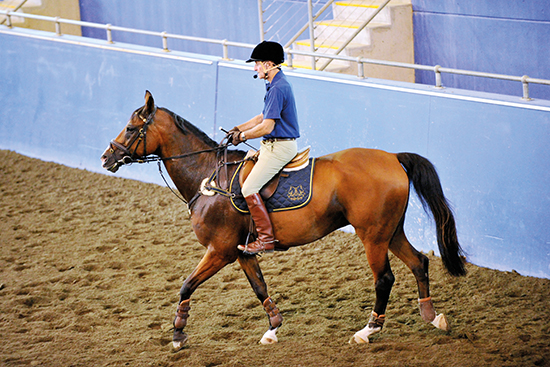
Of course the horse responds to George, time to give him back and start a jumping exercise. This time a vertical to an oxer, 88 feet apart, with a reverse half circle at each end, and the instruction to ride it in an easy seven not a six.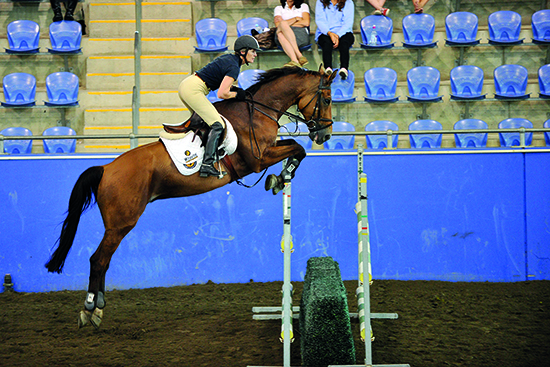
“Vicki, I want you to work the vertical / oxer back and forwards, stick to the seven.” Guess what, Vicki who has always proclaimed her inability to count strides had a breakthrough during the clinic, and suddenly found that she could!
Rider position is critical: “Hilary, STOP! What’s important is not how far you are out of the saddle – get your body further forward and closer to the saddle. Get into the base so that your horse backs up and gets round, round, round. Let the fence shorten the horse. Use just enough hand and voice, but what is important is self preservation – let the fence teach the horse.”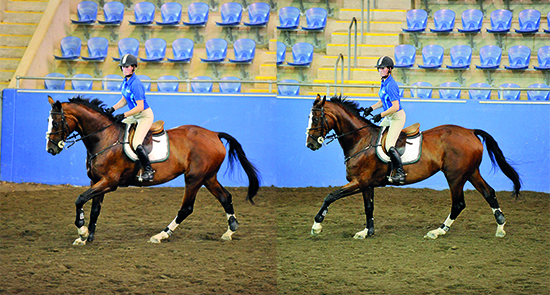
Poor Amanda Madigan kept copping it for standing off her fences: “Amanda, you are so complicated my dear. The horse has to practice and get comfortable with those deep spots. Don’t even consider the longer distance.”
It was time for George’s ‘impulsion test’: “Jump the Liverpool but we take away the speed and do it in trot. It is important for impulsion that they are thinking forward, use your legs, cluck, touch with the whip if necessary. The horse has to think forward – impulsion is in the horse’s brain.”
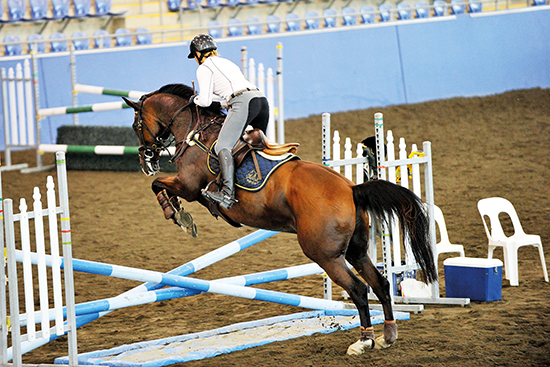 And of course, the other side of the impulsion coin was the halt: “Dressage today is awful, they don’t judge the halts, they don’t really use the marks from one to ten – they give the famous people nine or ten, and seven for the rest of them. The great Josef Neckermann used to ride hundreds of halts a day, it is the first and last movement of the dressage test.
And of course, the other side of the impulsion coin was the halt: “Dressage today is awful, they don’t judge the halts, they don’t really use the marks from one to ten – they give the famous people nine or ten, and seven for the rest of them. The great Josef Neckermann used to ride hundreds of halts a day, it is the first and last movement of the dressage test.
The next exercise was an oxer to the Liverpool to a Swedish oxer: “Six strides between each jump. That’s five Amanda, and that is not an option, it is a cop out. This is a simple exercise but it involves precision, modern showjumping is precision on broken lines.”
Oh dear, poor Amanda gets a seven and a five: “Repeat, repeat my dear. There is already a Saint George, maybe I am Saint George the second, I have the patience of a saint. If you are smart you ride the first to the second more direct, the second to the third more out. Ride it both ways – precision duplicated, precision over and over and over. That was perfect Amanda my dear, it’s simple. Practice is to get confidence, practice is so it gets easy, so you get confidence in that short stride. This is the sport today, not massive like it was in my day, tricky jumping.”
“Bending lines are becoming more popular in the sport because of their difficulty. The indoor German shows are all bending lines, they are good to supple the horse, good for the rider’s precision. Look at the tracks at the Hong Kong Games, they were very tricky and trappy. If you have a good horse, and if your horse is well schooled, and the horse and rider are well prepped, any course should suit them. Riders moan about Leopoldo’s (Palacios) courses, about how hard the time is to get, but that’s his trademark, and you’ve got to adjust – learn to ride a roll-back, learn to leave out strides.”
more follows
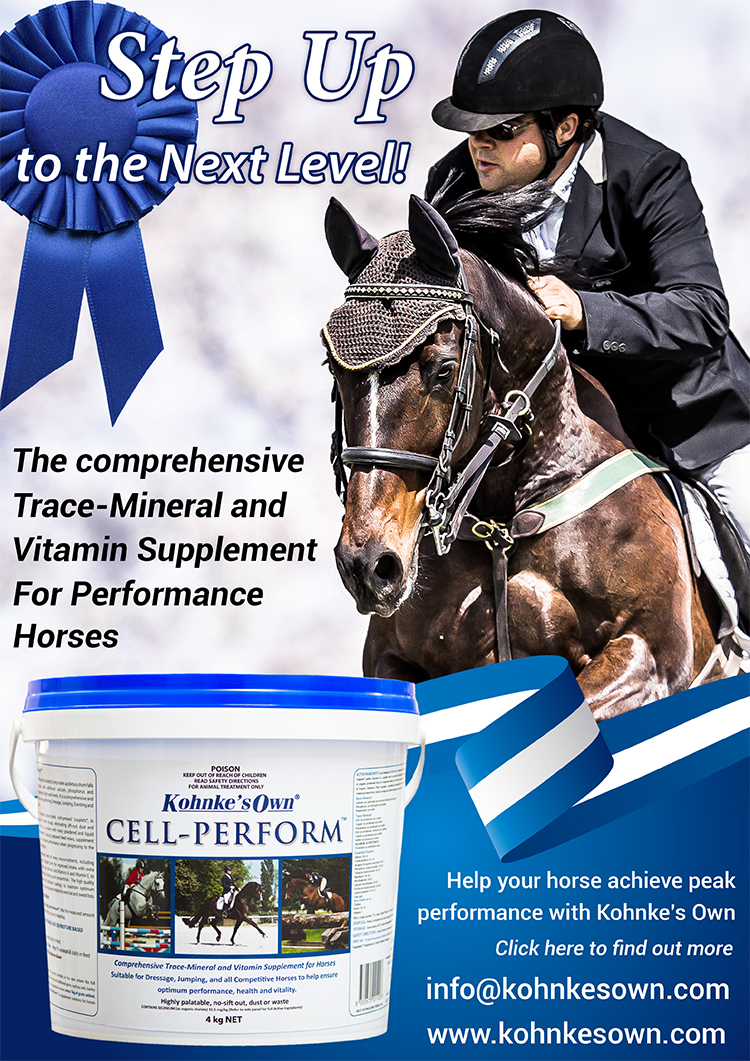
clickhttp://www.kohnkesown.com
“The riders here in Australia are much better than they were in the 80s when I first came, when they didn’t have any legs, but you still need better legs. Look at Meredith (Michaels-Beerbaum), her lower leg never moves. That leg position has to be taught so consistently that in competition, the leg never moves. You don’t need tricky stirrup irons with magnets, get into the habit of keeping your legs in position with proper stirrups.”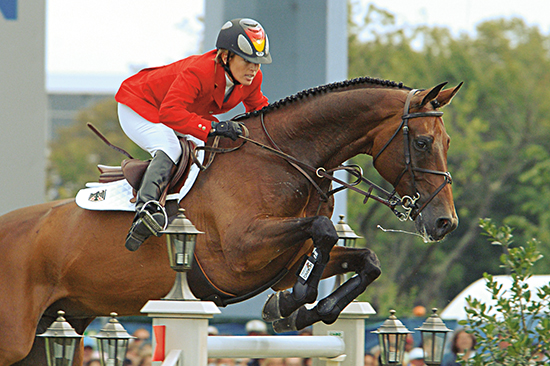
Meredith – her lower leg never moves
George then sets up one of his amazing lines, that all by themselves teach both horse and rider, over the Liverpool, hard turn left across the diagonal curving left onto one of those triple bars with the top two rails at the same height, then 84.6 feet to an oxer, 24.6 to an offset oxer and a steady four to the wall.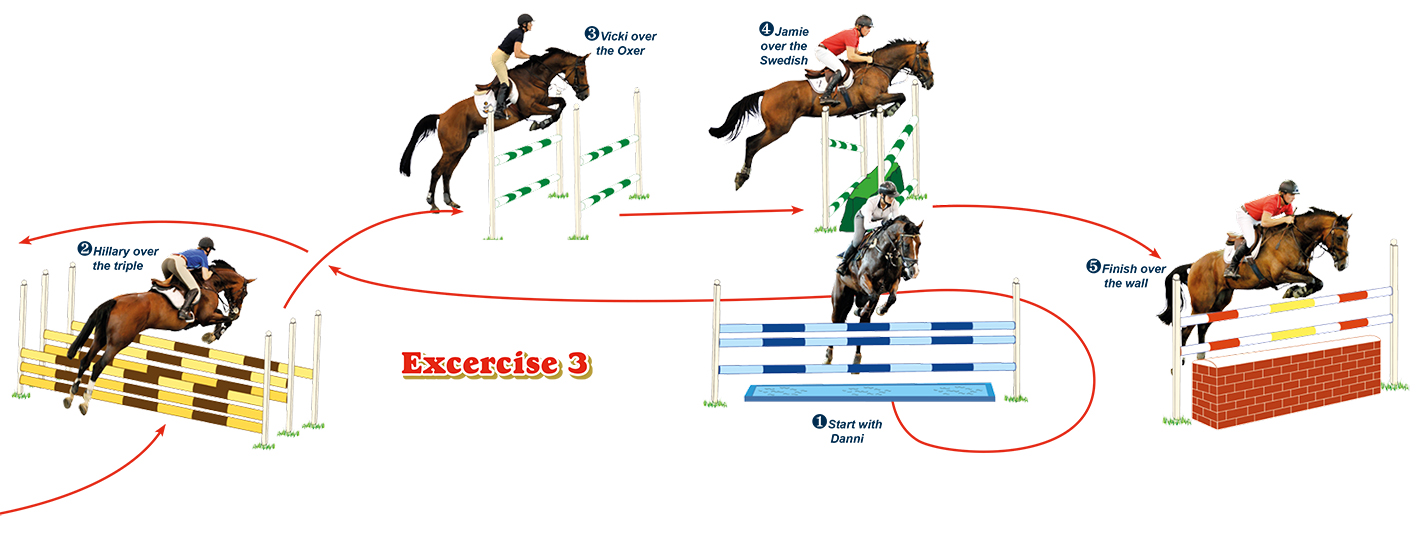
“The sport of showjumping is softer, the jumps are lower and you have to be able to make a short turn on landing, you must be able to jump the fence on a short stride.”
“It’s not practice that makes perfect, but perfect practice makes perfect. Horses have to be taught these more sophisticated problems. The fences I construct are often very airy and very parallel, the horse has to teach himself.”
“Top dressage, eventing, showjumping, they are all the same, meticulous. McLain Ward is obsessive, he makes me look slack, but that’s the sport today. It’s the precision of competition riding, exact details, detailed but simple – basics are detailed, but simple. Look at Rodrigo Pessoa and Eric Lamaze, very classical, very detailed. Look at John Whitaker, great horse people are fastidious.”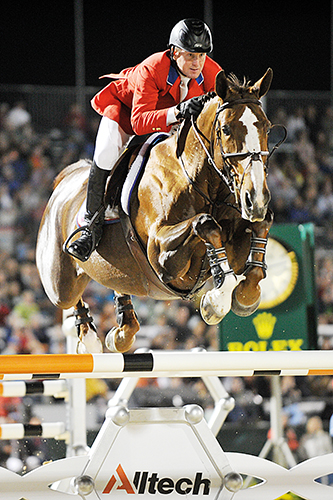
“McLain Ward is obsessive, he makes me look slack”
The second group was the same as on the first day, except for Stuart Tinney who was riding a Graf Landau mare, Kinnordy Genuine.
After the usual series of dressage exercises, the group were to canter to a pair of offset fences, practicing shortening at the first fence, lengthening between the fences and shortening in front of the second.
“Practice it so they associate the fence with shortening.”
Time for a little more dressage. The riders were to start in canter, doing simple changes on the long side, then walk through the corner, take up counter canter, and flying change on the long side. Did that cause a few problems!
Then the riders had to canter over two poles with a flying change over the pole.
“The poles are just to keep your horses straight – you are so obsessed with neck bending.”
“This system advocates the very old Caprilli forward seat. Now there are some people who think Caprilli is outdated but all the best riders in the world use it. It is the old classic jumping position that lets the horse used his head, neck and back. What does it look like? Stirrups short, heels down, seat light, upper body forward, eyes ahead and horse straight for jump after jump.”
read on for another challenge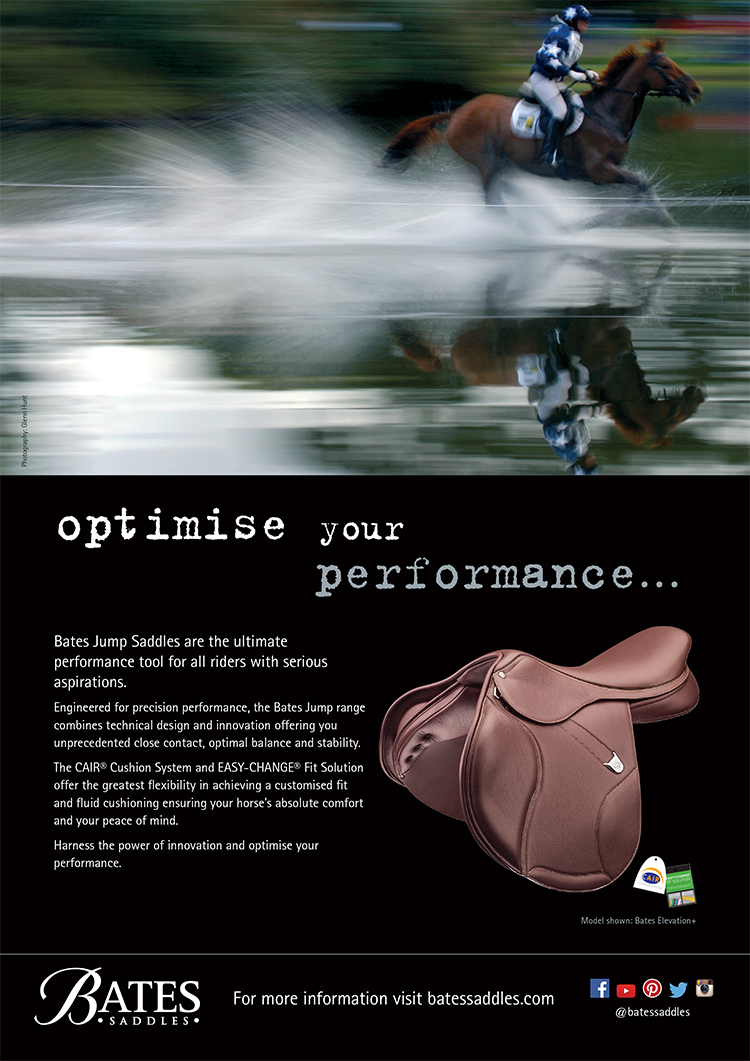
clickhttp://www.batessaddles.com
“Look at Stuart over these cross rails, that’s the picture of the forward seat. He’s not resting his hands, his hands are beside the horse’s neck. Let the horses come to the first fence so they get deep.”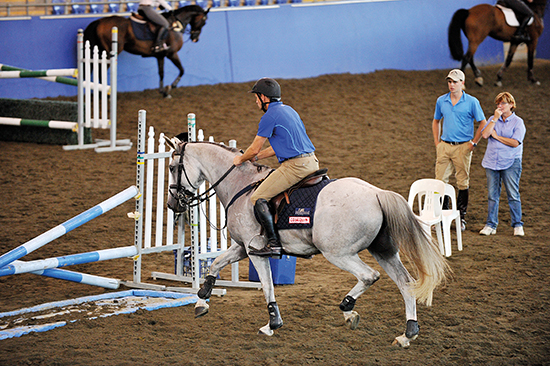
Stuart Tinney and Kinnordy Genuine
There was a new challenge: “Come in trot to the water with dropped stirrup, this is so you can practice getting your stirrups back – fish with your toes, don’t look down. Good, now canter to the jump with dropped stirrups, jump and turn, and then get your stirrups. You are going to lose your stirrups at a competition, you have to practice at home so it is not a problem.
Another bending line…
“Ride the first six more direct, and ride the second six, further out. Then turn around and ride back again, and again, it’s great for the horse, it softens the horse.”
But it always comes back to riding and to the rider’s position:
“Look at the great riders even in Germany, like Winkler and Schridde, they rode in a light riding seat. Now the sport is based on horse dealers who ride in a defensive position and herd them over the fences. That style, heavy riding way behind the movement, that’s a tactic to sell bad horses. We have two point contact and three point contact – in two point contact, the rider’s upper body is 30 degrees from the vertical with the seat slightly above the saddle, in three point, the seat and legs are in the saddle. From a two point seat, just in before the fence, the rider sinks into three point. Look at Beezie Madden, she is one of the best riders in history, she exemplifies two point contact.’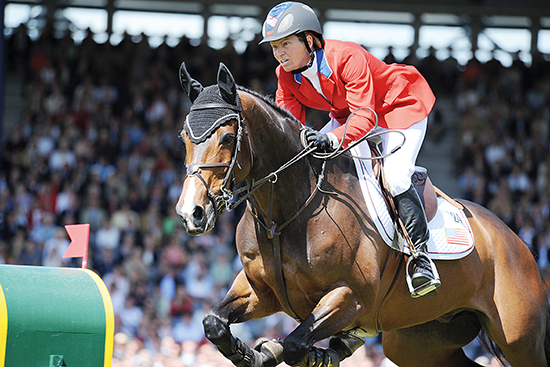
“I want you to gallop in two point along the arena wall, as you get to the jump, sink into the saddle for the jump, then back to two point and gallop away. Don’t straighten too much when you sink into the saddle, and make sure it is a soft seat for these sharp horses.”
This article first appeared in the April 2011 issue of THM.
For more from George, go to:


